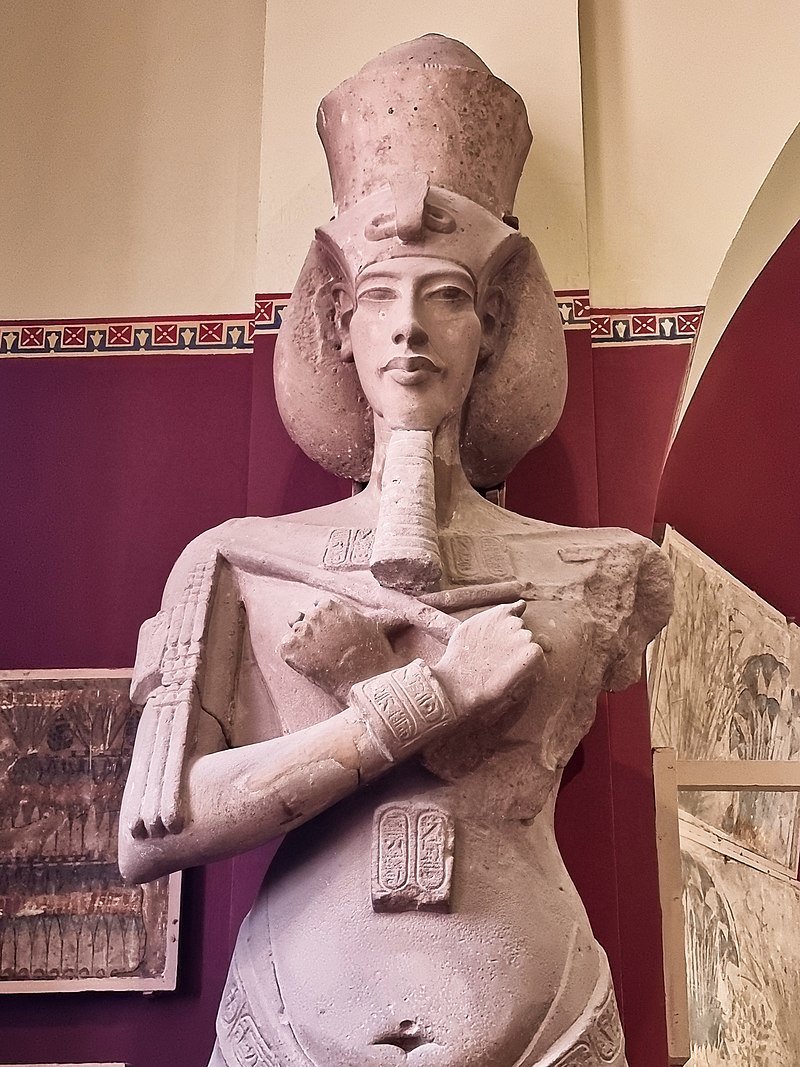
A
statute of Akhenaten at the Cairo Museum of Antiquities
Akhenaten also spelled Akhenaton or Echnaton, meaning 'Effective for the Aten', was an
Ancient
Egyptian pharaoh reigning c. 1353–1336 or 1351–1334 BC, the tenth ruler of the Eighteenth Dynasty. Before the fifth year of his reign, he was known as Amenhotep IV (Ancient Egyptian: jmn-ḥtp, meaning "Amun is satisfied", Hellenized as Amenophis IV).
As a pharaoh, Akhenaten is noted for abandoning Egypt's traditional polytheism and introducing Atenism, or worship centered around Aten. The views of Egyptologists differ as to whether the religious policy was absolutely monotheistic, or whether it was monolatristic, syncretistic, or henotheistic. This culture shift away from traditional religion was reversed after his death. Akhenaten's monuments were dismantled and hidden, his statues were destroyed, and his name excluded from lists of rulers compiled by later pharaohs. Traditional religious practice was gradually restored, notably under his close successor Tutankhamun, who changed his name from Tutankhaten early in his reign. When some dozen years later, rulers without clear rights of succession from the Eighteenth Dynasty founded a new dynasty, they discredited Akhenaten and his immediate successors and referred to Akhenaten as "the enemy" or "that criminal" in archival records.
Akhenaten was all but lost to history until the late-19th-century discovery of Amarna, or Akhetaten, the new capital city he built for the worship of Aten. Furthermore, in 1907, a
mummy that could be Akhenaten's was unearthed from the tomb KV55 in the Valley of the Kings by Edward R. Ayrton. Genetic testing has determined that the man buried in KV55 was Tutankhamun's father, but its identification as Akhenaten has since been questioned.
Akhenaten's rediscovery and Flinders Petrie's early excavations at Amarna sparked great public interest in the pharaoh and his queen Nefertiti. He has been described as "enigmatic", "mysterious", "revolutionary", "the greatest idealist of the world", and "the first individual in history", but also as a "heretic", "fanatic", "possibly insane", and "mad". Public and scholarly fascination with Akhenaten comes from his connection with Tutankhamun, the unique style and high quality of the pictorial arts he patronized, and the religion he attempted to establish, foreshadowing monotheism.
Egyptologists know very little about Akhenaten's life as prince Amenhotep. Donald B. Redford dates his birth before his father Amenhotep III's 25th regnal year, C. 1363–1361 BC, based on the birth of Akhenaten's first daughter, who was likely born fairly early in his own reign. The only mention of his name, as "the King's Son Amenhotep," was found on a wine docket at Amenhotep III's Malkata palace, where some historians suggested Akhenaten was born. Others contend that he was born at Memphis, where growing up he was influenced by the worship of the sun god Ra practiced at nearby Heliopolis. Redford and James K. Hoffmeier state, however, that Ra's cult was so widespread and established throughout Egypt that Akhenaten could have been influenced by solar worship even if he did not grow up around Heliopolis.
Some historians have tried to determine who was Akhenaten's tutor during his youth, and have proposed scribes Heqareshu or Meryre II, the royal tutor Amenemotep, or the vizier Aperel. The only person who we know for certain served the prince was Parennefer, whose tomb mentions this fact.
Egyptologist Cyril Aldred suggests that prince Amenhotep might have been a High Priest of Ptah in Memphis, although no evidence supporting this had been found. It is known that Amenhotep's brother, crown prince Thutmose, served in this role before he died. If Amenhotep inherited all his brother's roles in preparation for his accession to the throne, he might have become a high priest in Thutmose's stead. Aldred proposes that Akhenaten's unusual artistic inclinations might have been formed during his time serving Ptah, the patron god of craftsmen, whose high priest were sometimes referred to as "The Greatest of the Directors of Craftsmanship."
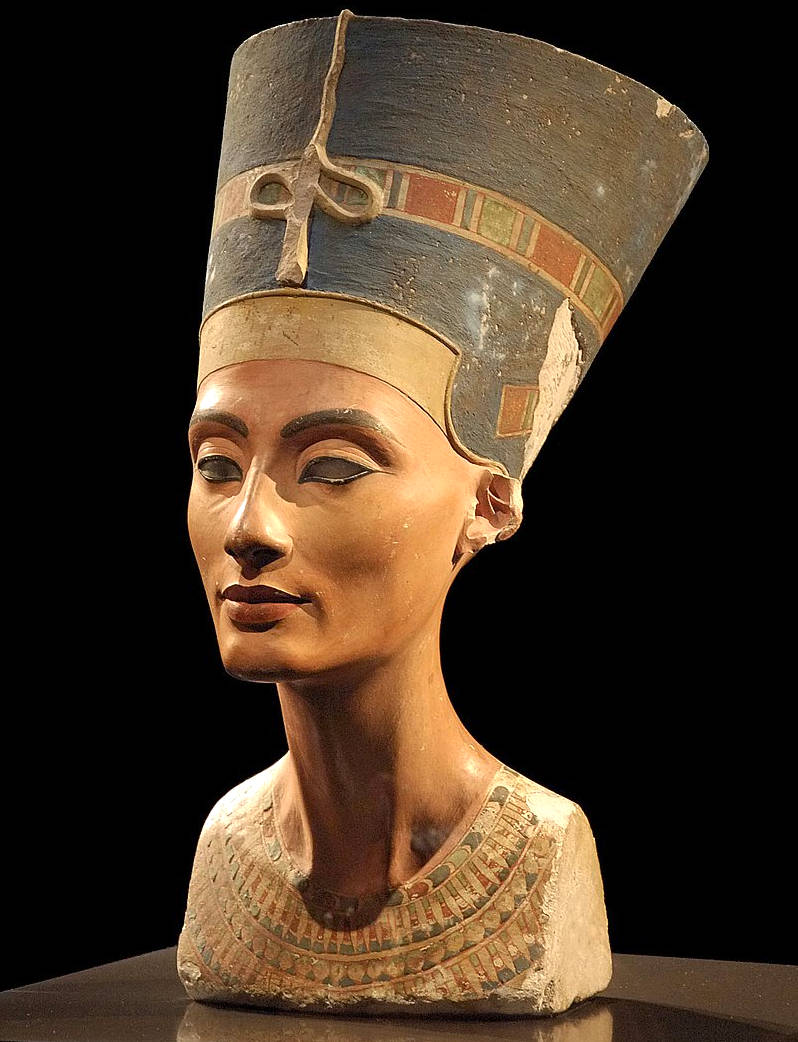
Nefertiti
bust
DEATH & BURIAL
Akhenaten died after seventeen years of rule and was initially buried in a tomb in the Royal Wadi east of Akhetaten. The order to construct the tomb and to bury the pharaoh there was commemorated on one of the boundary stela delineating the capital's borders: "Let a tomb be made for me in the eastern mountain [of Akhetaten]. Let my burial be made in it, in the millions of jubilees which the
Aten, my father, decreed for me." In the years following the burial, Akhenaten's sarcophagus was destroyed and left in the Akhetaten necropolis; reconstructed in the 20th century, it is in the Egyptian Museum in Cairo as of 2019. Despite leaving the sarcophagus behind, Akhenaten's mummy was removed from the royal tombs after Tutankhamun abandoned Akhetaten and returned to Thebes. It was most likely moved to tomb KV55 in Valley of the Kings near Thebes. This tomb was later desecrated, likely during the Ramesside period.
Whether Smenkhkare also enjoyed a brief independent reign after Akhenaten is unclear. If Smenkhkare outlived Akhenaten, and became sole pharaoh, he likely ruled Egypt for less than a year. The next successor was Nefertiti or Meritaten ruling as Neferneferuaten, reigning in Egypt for about two years. She was, in turn, probably succeeded by Tutankhaten, with the country being administered by the vizier and future pharaoh Ay.
While Akhenaten - along with Smenkhkare - was most likely reburied in tomb KV55, the identification of the mummy found in that tomb as Akhenaten remains controversial to this day. The mummy has repeatedly been examined since its discovery in 1907. Most recently, Egyptologist
Zahi Hawass led a team of researchers to examine the mummy using medical and DNA analysis, with the results published in 2010. In releasing their test results, Hawass's team identified the mummy as the father of Tutankhamun and thus "most probably" Akhenaten. However, the study's validity has since been called into question. For instance, the discussion of the study results does not discuss that Tutankhamun's father and the father's siblings would share some genetic markers; if Tutankhamun's father was Akhenaten, the
DNA results could indicate that the mummy is a brother of Akhenaten, possibly Smenkhkare.
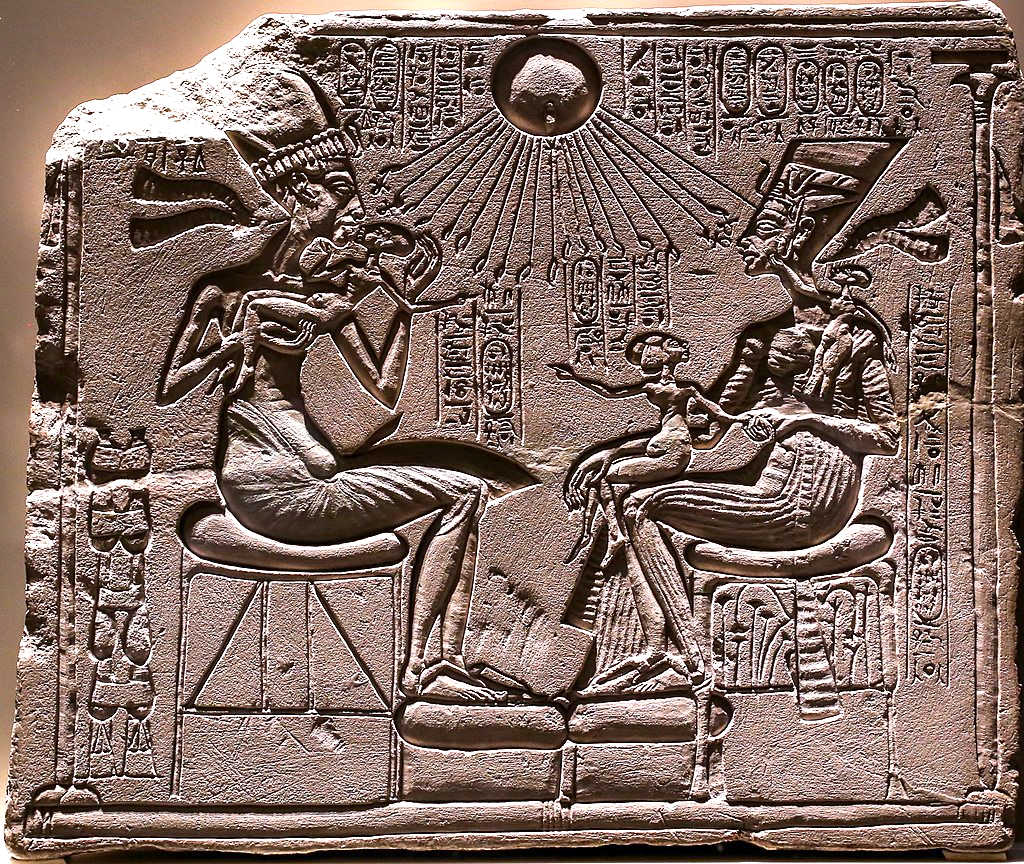
A
stone relief showing Akhenaten and his wife Nefertiti with
three of their daughters
LEGACY
With Akhenaten's death, the Aten cult he had founded fell out of favor: at first gradually, and then with decisive finality. Tutankhaten changed his name to
Tutankhamun
in Year 2 of his reign (c. 1332 BC) and abandoned the city of Akhetaten. Their successors then attempted to erase Akhenaten and his family from the historical record. During the reign of Horemheb, the last pharaoh of the Eighteenth Dynasty and the first pharaoh after Akhenaten who was not related to Akhenaten's family, Egyptians started to destroy temples to the Aten and reuse the building blocks in new construction projects, including in temples for the newly restored god Amun. Horemheb's successor continued in this effort. Seti I restored monuments to Amun and had the god's name re-carved on inscriptions where it was removed by Akhenaten. Seti I also ordered that Akhenaten, Smenkhkare, Neferneferuaten, Tutankhamun, and Ay be excised from official lists of pharaohs to make it appear that Amenhotep III was immediately succeeded by Horemheb. Under the Ramessides, who succeeded Seti I, Akhetaten was gradually destroyed and the building material reused across the country, such as in constructions at Hermopolis. The negative attitudes toward Akhenaten were illustrated by, for example, inscriptions in the tomb of scribe Mose (or Mes), where Akhenaten's reign is referred to as "the time of the enemy of Akhet-Aten."
Some Egyptologists, such as Jacobus van Dijk and Jan Assmann, believe that Akhenaten's reign and the Amarna period started a gradual decline in the Egyptian government's power and the pharaoh's standing in Egyptian's society and religious life. Akhenaten's religious reforms subverted the relationship ordinary Egyptians had with their gods and their pharaoh, as well as the role the pharaoh played in the relationship between the people and the gods. Before the Amarna period, the pharaoh was the representative of the gods on Earth, the son of the god Ra, and the living incarnation of the god Horus, and maintained the divine order through rituals and offerings and by sustaining the temples of the gods. Additionally, even though the pharaoh oversaw all religious activity, Egyptians could access their gods through regular public holidays, festivals, and processions. This led to a seemingly close connection between people and the gods, especially the patron deity of their respective towns and cities.
Akhenaten, however, banned the worship of gods beside the Aten, including through festivals. He also declared himself to be the only one who could worship the Aten, and required that all religious devotion previously exhibited toward the gods be directed toward himself. After the Amarna period, during the Nineteenth and Twentieth Dynasties—c. 270 years following Akhenaten's death—the relationship between the people, the pharaoh, and the gods did not simply revert to pre-Amarna practices and beliefs. The worship of all gods returned, but the relationship between the gods and the worshipers became more direct and personal, circumventing the pharaoh. Rather than acting through the pharaoh, Egyptians started to believe that the gods intervened directly in their lives, protecting the pious and punishing criminals. The gods replaced the pharaoh as their own representatives on Earth. The god Amun once again became king among all gods. According to van Dijk, "the king was no longer a god, but god himself had become king. Once Amun had been recognized as the true king, the political power of the earthly rulers could be reduced to a minimum." Consequently, the influence and power of the
Amun priesthood continued to grow until the Twenty-first Dynasty, c. 1077 BC, by which time the High Priests of Amun effectively became rulers over parts of Egypt.
Akhenaten's reforms also had a longer-term impact on Ancient Egyptian language and hastened the spread of the spoken Late Egyptian language in official writings and speeches. Spoken and written Egyptian diverged early on in Egyptian history and stayed different over time. During the Amarna period, however, royal and religious texts and inscriptions, including the boundary stelae at Akhetaten or the Amarna letters, started to regularly include more vernacular linguistic elements, such as the definite article or a new possessive form. Even though they continued to diverge, these changes brought the spoken and written language closer to one another more systematically than under previous pharaohs of the New Kingdom. While Akhenaten's successors attempted to erase his religious, artistic, and even linguistic changes from history, the new linguistic elements remained a more common part of official texts following the Amarna years, starting with the Nineteenth Dynasty.
Akhenaten is also recognized as a Prophet in the Druze faith.
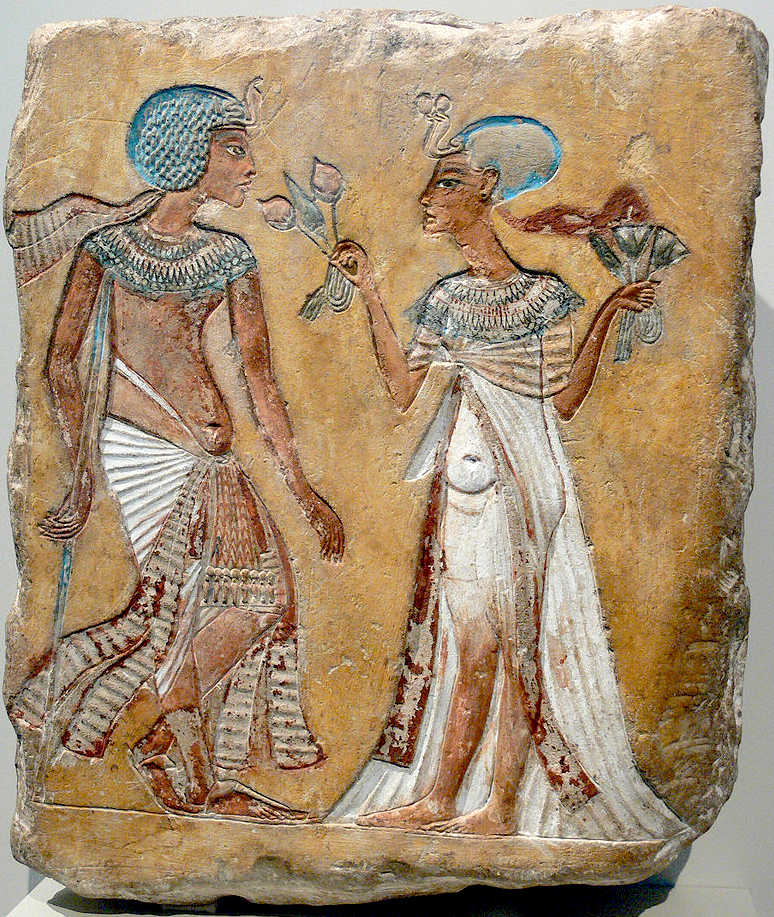
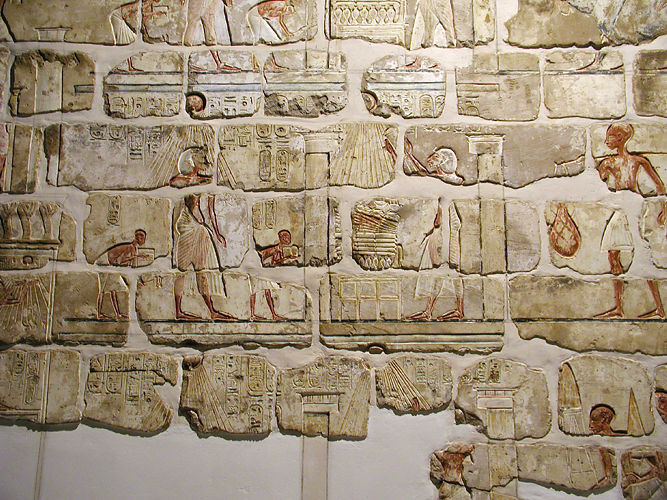
Temple
tablet relief's called talatats
ATENISM
Egyptians worshipped a sun god under several names, and solar worship had been growing in popularity even before Akhenaten, especially during the Eighteenth Dynasty and the reign of Amenhotep III, Akhenaten's father. During the New Kingdom, the pharaoh started to be associated with the sun disc; for example, one inscription called the pharaoh Hatshepsut the "female Re shining like the Disc," while Amenhotep III was described as "he who rises over every foreign land, Nebmare, the dazzling disc." During the Eighteenth Dynasty, a religious hymn to the sun also appeared and became popular among Egyptians. However, Egyptologists question whether there is a causal relationship between the cult of the sun disc before Akhenaten and Akhenaten's religious policies.
The implementation of
Atenism can be traced through gradual changes in the Aten's iconography, and Egyptologist Donald B. Redford divided its development into three
stages - earliest, intermediate, and final - in his studies of Akhenaten and Atenism. The earliest stage was associated with a growing number of depictions of the sun disc, though the disc is still seen resting on the head of the falcon-headed sun god Ra-Horakhty, as the god was traditionally represented. The god was only "unique but not exclusive." The intermediate stage was marked by the elevation of the Aten above other gods and the appearance of cartouches around his inscribed
name - cartouches traditionally indicating that the enclosed text is a royal name. The final stage had the Aten represented as a sun disc with sunrays like long arms terminating in human hands and the introduction of a new epithet for the god: "the great living Disc which is in jubilee, lord of heaven and earth."
In the early years of his reign, Amenhotep IV lived at Thebes, the old capital city, and permitted worship of
Egypt's traditional deities to continue. However, some signs already pointed to the growing importance of the Aten. For example, inscriptions in the Theban tomb of Parennefer from the early rule of Amenhotep IV state that "one measures the payments to every (other) god with a level measure, but for the Aten one measures so that it overflows," indicating a more favorable attitude to the cult of Aten than the other gods. Additionally, near the Temple of Karnak, Amun-Ra's great cult center, Amenhotep IV erected several massive buildings including temples to the Aten. The new Aten temples had no roof and the god was thus worshipped in the sunlight, under the open sky, rather than in dark temple enclosures as had been the previous custom. The Theban buildings were later dismantled by his successors and used as infill for new constructions in the Temple of Karnak; when they were later dismantled by archaeologists, some 36,000 decorated blocks from the original Aten building here were revealed that preserve many elements of the original relief scenes and inscriptions.
One of the most important turning points in the early reign of Amenhotep IV is a speech given by the pharaoh at the beginning of his second regnal year. A copy of the speech survives on one of the pylons at the Karnak Temple Complex near Thebes. Speaking to the royal court, scribes or the people, Amenhotep IV said that the gods were ineffective and had ceased their movements, and that their temples had collapsed. The pharaoh contrasted this with the only remaining god, the sun disc Aten, who continued to move and exist forever. Some Egyptologists, such as Donald B. Redford, compared this speech to a proclamation or manifesto, which foreshadowed and explained the pharaoh's later religious reforms centered around the Aten. In his speech, Akhenaten said:
" The temples of the gods fallen to ruin, their bodies do not endure. Since the time of the ancestors, it is the wise man that knows these things. Behold, I, the king, am speaking so that I might inform you concerning the appearances of the gods. I know their temples, and I am versed in the writings, specifically, the inventory of their primeval bodies. And I have watched as they [the gods] have ceased their appearances, one after the other. All of them have stopped, except the god who gave birth to himself. And no one knows the mystery of how he performs his tasks. This god goes where he pleases and no one else knows his going. I approach him, the things which he has made. How exalted they are."
In Year Five of his reign, Amenhotep IV took decisive steps to establish the Aten as the sole god of Egypt. The pharaoh "disbanded the priesthoods of all the other gods ... and diverted the income from these [other] cults to support the Aten." To emphasize his complete allegiance to the Aten, the king officially changed his name from Amenhotep IV to Akhenaten (Ancient Egyptian: ꜣḫ-n-jtn, meaning "Effective for the Aten"). Meanwhile, the Aten was becoming a king itself. Artists started to depict him with the trappings of pharaohs, placing his name in
cartouches — a rare, but not unique occurrence, as the names of Ra-Horakhty and Amun-Ra had also been found enclosed in cartouches — and wearing a uraeus, a symbol of kingship. The Aten may also have been the subject of Akhenaten's royal Sed festival early in the pharaoh's reign. With Aten becoming a sole deity, Akhenaten started to proclaim himself as the only intermediary between Aten and his people, and the subject of their personal worship and attention — a feature not unheard of in Egyptian history, with Fifth Dynasty pharaohs such as Nyuserre Ini proclaiming to be sole intermediaries between the people and the gods Osiris and Ra.
By Year Nine of his reign, Akhenaten declared that Aten was not merely the supreme god, but the only worshipable god. He ordered the defacing of Amun's temples throughout Egypt and, in a number of instances, inscriptions of the plural 'gods' were also removed. This emphasized the changes encouraged by the new regime, which included a ban on images, with the exception of a rayed solar disc, in which the rays appear to represent the unseen spirit of Aten, who by then was evidently considered not merely a sun god, but rather a universal deity. All life on Earth depended on the Aten and the visible sunlight. Representations of the Aten were always accompanied with a sort of hieroglyphic footnote, stating that the representation of the sun as all-encompassing creator was to be taken as just that: a representation of something that, by its very nature as something transcending creation, cannot be fully or adequately represented by any one part of that creation. Aten's name was also written differently starting as early as Year Eight or as late as Year Fourteen, according to some historians. From "Living Re-Horakhty, who rejoices in the horizon in his name Shu-Re who is in Aten," the god's name changed to "Living Re, ruler of the horizon, who rejoices in his name of Re the father who has returned as Aten," removing the Aten's connection to Re-Horakhty and Shu, two other solar deities. The Aten thus became an amalgamation that incorporated the attributes and beliefs around Re-Horakhty, universal sun god, and Shu, god of the sky and manifestation of the sunlight.
Akhenaten's Atenist beliefs are best distilled in the Great Hymn to the Aten. The hymn was discovered in the tomb of Ay, one of Akhenaten's successors, though Egyptologists believe that it could have been composed by Akhenaten himself. The hymn celebrates the sun and daylight and recounts the dangers that abound when the sun sets. It tells of the Aten as a sole god and the creator of all life, who recreates life every day at sunrise, and on whom everything on Earth depends, including the natural world, people's lives, and even trade and commerce. In one passage, the hymn declares: "O Sole God beside whom there is none! You made the earth as you wished, you
alone." The hymn also states that Akhenaten is the only intermediary between the god and Egyptians, and the only one who can understand the Aten: "You are in my heart, and there is none who knows you except your son."
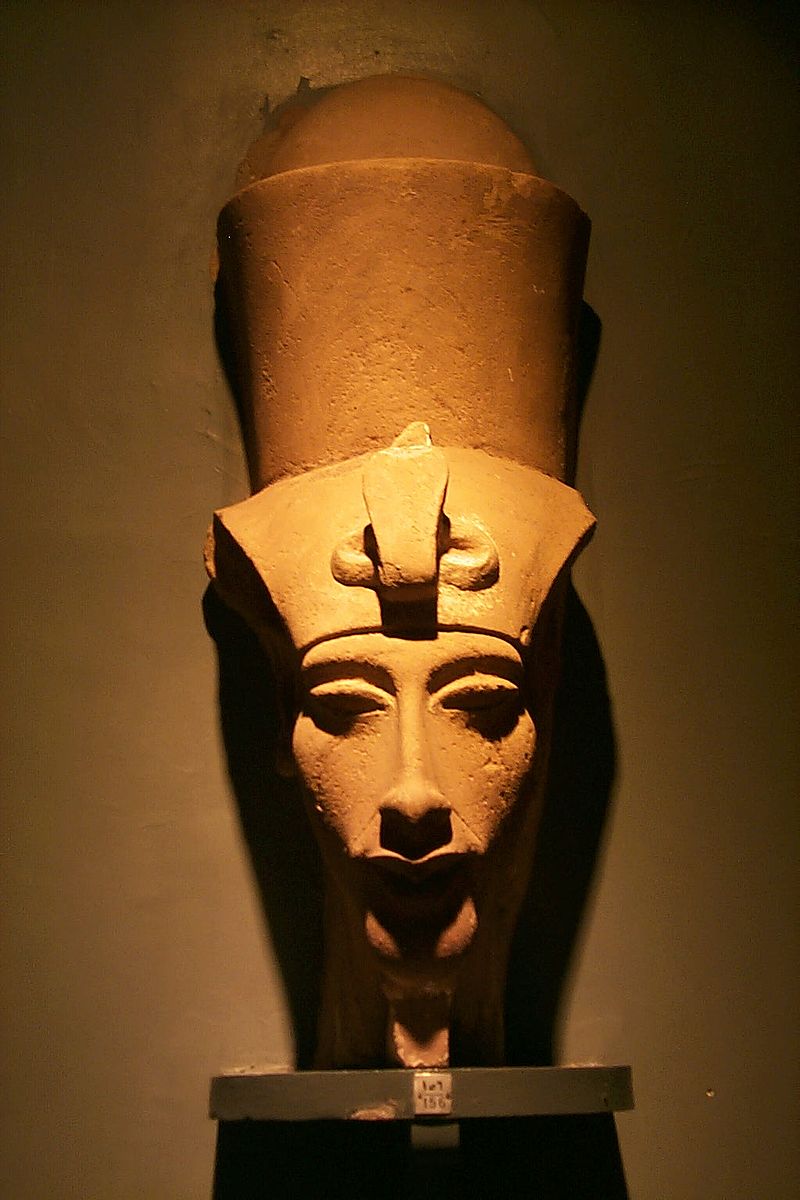
A
bust of Akhenaten, showing his elongated head as a feature
NOTABLE KINGS
Djoser
Khufu
Khafre
Ahmose
Amenhotp I
Thutmose I, II, III
Ramesses I, II III, VI, VIII, IX, X, XI
Amenhotep II
Akhenaten
Tutankamun
Seti I & II
Alexander the Great
Ptolemy I Soter I
Ptolemy IV Philopator
Ptolemy VI Philometor
Ptolemy IX Soter II
NOTABLE QUEENS
Arsinoe II
Cleopatra I, II
Hatshepsut
Sobekneferu
(Neferusobek)
Nefertiti,
beautiful ancient Egyptian queen, architect of the sun cult
Cleopatra
VII
last queen of Egypt
Amina, queen for 34 years in Nigeria
Candace,
Ethiopian Empress, fearsome fighter who resisted Alexander the
Great
Semiramis,
female ruler Assyrian empire.
REFERENCE
https://www.
CLEOPATRA
THE MUMMY
'Cleopatra
- The Mummy' is an original story in the John Storm franchise (for which a
draft
script is published for studios, producers and directors). The
John Storm
franchise is a series of
ocean awareness adventures, featuring the incredible solar
powered trimaran: Elizabeth
Swann.